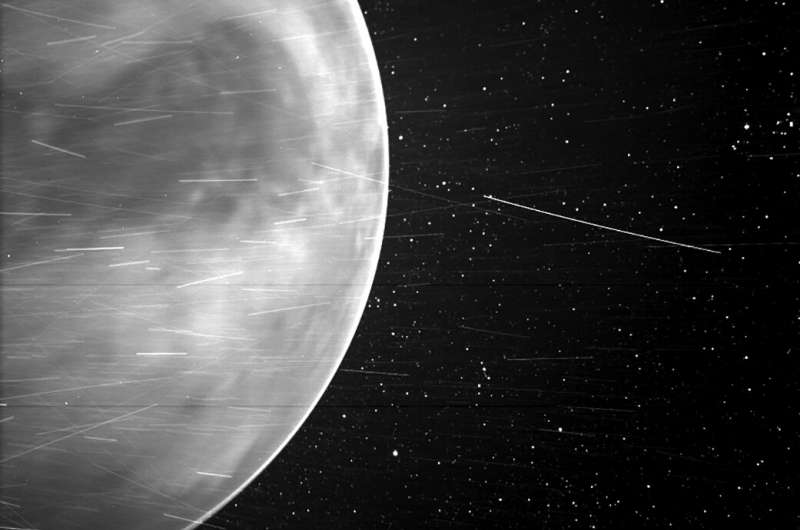Parker discovers natural radio emission in Venus’ atmosphere

During a brief swing by Venus, NASA’s Parker Solar Probe detected a natural radio signal that revealed the spacecraft had flown through the planet’s upper atmosphere. This was the first direct measurement of the Venusian atmosphere in nearly 30 years—and it looks quite different from Venus past. A study published today confirms that Venus’ upper atmosphere undergoes puzzling changes over a solar cycle, the Sun’s 11-year activity cycle. This marks the latest clue to untangling how and why Venus and Earth are so different.
Born of similar processes, Earth and Venus are twins: both rocky, and of similar size and structure. But their paths diverged from birth. Venus lacks a magnetic field, and its surface broils at temperatures hot enough to melt lead. At most, spacecraft have only ever survived a couple hours there. Studying Venus, inhospitable as it is, helps scientists understand how these twins have evolved, and what makes Earth-like planets habitable or not.
On July 11, 2020, Parker Solar Probe swung by Venus in its third flyby. Each flyby is designed to leverage the planet’s gravity to fly the spacecraft closer and closer to the Sun. The mission—managed by Johns Hopkins Applied Physics Laboratory in Laurel, Maryland—made its closest flyby of Venus yet, passing just 517 miles (833 km) above the surface.
“I was just so excited to have new data from Venus,” said Glyn Collison of NASA’s Goddard Space Flight Center in Greenbelt, Maryland, the lead scientist on the study, published today in Geophysical Research Letters. A Venus expert, Collinson has pored over all the Venus data available—from past missions like NASA’s Pioneer Venus Orbiter and ESA’s (the European Space Agency) Venus Express—several times.
One of Parker Solar Probe’s instruments is FIELDS, named for the electric and magnetic fields it measures in the Sun’s atmosphere. For just seven minutes—when Parker Solar Probe was closest to Venus—FIELDS detected a natural, low-frequency radio signal. The thin frown in the data caught Collinson’s attention. The shape and strength of the signal seemed familiar, but he could not place it. “Then the next day, I woke up,” he said. “And I thought, ‘Oh my god, I know what this is!'”
Collinson recognized the signal from his previous work with NASA’s Galileo orbiter, which explored Jupiter and its moons before the mission ended in 2003. A similar frown appeared whenever the spacecraft passed through the ionospheres of Jupiter’s moons.
Like Earth, Venus sports an electrically charged layer of gas at the upper edge of its atmosphere, called the ionosphere. This sea of charged gases, or plasma, naturally emits radio waves that can be detected by instruments like FIELDS. When Collinson and his team identified that signal, they realized Parker Solar Probe had skimmed Venus’ upper atmosphere—a pleasant surprise, though one they might have expected based on previous data, he said.
The data sonification in the video translates data from Parker Solar Probe’s FIELDS instrument into sound. FIELDS detected a natural, low-frequency radio emission as it moved through Venus’ atmosphere that helped scientists calculate the density of the planet’s electrically charged upper atmosphere, called the ionosphere. Credit: NASA’s Scientific Visualization Studio/Mark SubbaRao/Glyn Collinson
The researchers used this radio emission to calculate the density of the ionosphere that Parker Solar Probe flew through. Researchers last obtained direct measurements of Venus’ ionosphere from Pioneer Venus Orbiter in 1992. Then, the Sun was near solar maximum, the stormy peak of the solar cycle.
In the years that followed, data from ground-based telescopes suggested big changes were taking place as the Sun settled into its calm phase, solar minimum. While the bulk of the atmosphere remained the same, the ionosphere—which is at the top, where gases can escape to space—was much thinner during solar minimum.
Without direct measurements, it was impossible to confirm.
The observations from Parker Solar Probe’s recent flyby, which occurred six months after the latest solar minimum, verify the puzzle in Venus’ ionosphere. Indeed, Venus’ ionosphere is much thinner compared to previous measurements taken during solar maximum.
“When multiple missions are confirming the same result, one after the other, that gives you a lot of confidence that the thinning is real,” said Robin Ramstad, a study co-author and post-doctoral researcher at the Laboratory of Atmospheric and Space Physics at the University of Colorado, Boulder.
Understanding why Venus’ ionosphere thins near solar minimum is one part of unraveling how Venus responds to the Sun—which will help researchers determine how Venus, once so similar to Earth, became the world of scorching, toxic air it is today. For example, Venus’ ionosphere is prone to leaking, meaning the escape of energized gases into space. Gathering data on this and other changes in the ionosphere is key to understanding how Venus’ atmosphere has evolved over time.
This study was some 30 years in the making. It took a mission to Venus, and decades later, a state-of-the-art mission to the Sun. “The goal of flying by Venus is to slow down the spacecraft so that Parker Solar Probe can dive closer to the Sun,” said Nour E. Raouafi, Parker Solar Probe project scientist at the Applied Physics Laboratory. “But we would not miss the opportunity to gather science data and provide unique insights into a mysterious planet such as Venus.”
Collinson likened the research to hitchhiking. Venus scientists were eager to piggyback off Parker Solar Probe’s flyby for new data and views of Earth’s twin planet. “To see Venus now, it’s all about these little glimpses,” he said.



 Creators of mankind
Creators of mankind Description of “Tall white aliens”
Description of “Tall white aliens” Where they came from?
Where they came from? About hostile civilizations
About hostile civilizations The war for the Earth
The war for the Earth “Tall white aliens” about eternal life
“Tall white aliens” about eternal life Video: “Nordic aliens”
Video: “Nordic aliens” Aliens
Aliens Alien encounters
Alien encounters The aliens base
The aliens base UFO
UFO Technology UFO
Technology UFO Underground civilization
Underground civilization Ancient alien artifacts
Ancient alien artifacts Military and UFO
Military and UFO Mysteries and hypotheses
Mysteries and hypotheses Scientific facts
Scientific facts


















